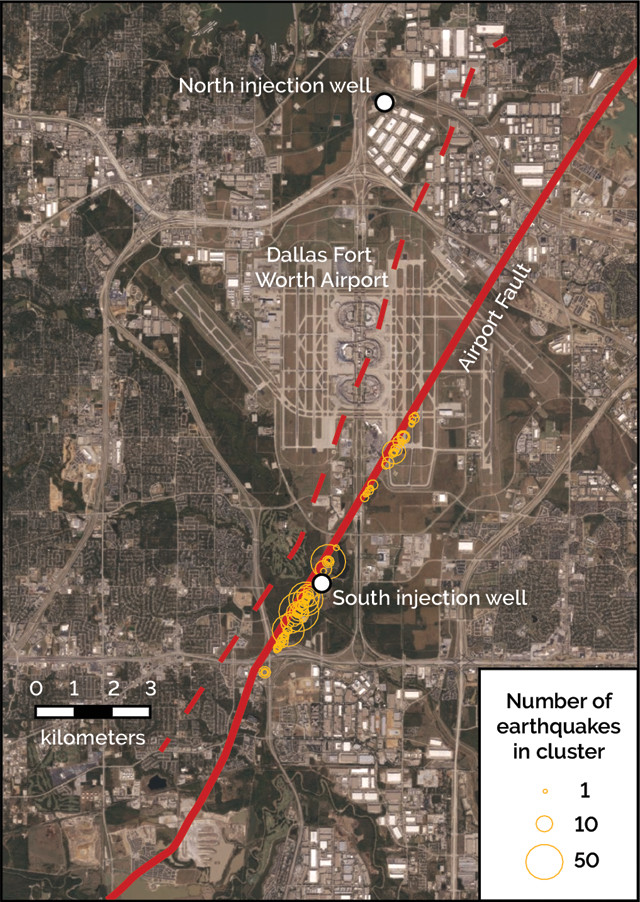
by Mary Caperton Morton Tuesday, May 1, 2018

Seismicity induced by wastewater injection around the Dallas/Fort Worth International Airport did not cease when injection stopped. The solid red line delineates the Airport Fault, while the dashed red line marks a cross section in a new pore pressure study. Credit: K. Cantner, AGI modified from Ogwari et al., 2018.
Since Oct. 31, 2008, when seismic activity was first detected, hundreds of earthquakes smaller than magnitude 3.4 have peppered a fault zone that partly underlies the Dallas/Fort Worth International Airport (DFW) in north-central Texas. After the quakes were linked to the subsurface disposal of wastewater fluids from oil and gas operations in wells located within a kilometer of the initial quakes, wastewater injections into those wells were halted in August 2009. A new study finds that quakes near the airport continued for years after the wells were shut down, suggesting that halting wastewater injection may not immediately stop induced seismicity.
Before Halloween 2008, the Fort Worth Basin had no historical record of seismicity. The region is underlain by the Barnett Shale, a major source of natural gas, as well as the Ellenburger Formation, a granite basement layer that is used for wastewater injection and storage. Throughout recorded history, the northeast-southwest trending normal fault system that runs through these layers was static. But injections of wastewater into these formations changed the pore pressures in the rocks, and seven months after the first injections, seismometers detected earthquakes along the fault system.
Paul Ogwari of Southern Methodist University in Dallas and colleagues analyzed seismic data collected between 2008 and 2015. Using additional seismic stations, the team tripled the known earthquake catalog in the region, producing the most complete dataset yet. In total, they found more than 400 induced quakes between magnitude 0.5 and 3.4, the largest of which were felt by people in the heavily populated Dallas-Fort Worth area.
The analysis, published in the Journal of Geophysical Research: Solid Earth, reveals curious patterns in the seismic record. The frequency of the quakes decreased since injection stopped — from dozens of events per month in 2008 and 2009 to a handful a month in recent years — but the magnitudes have remained consistent. “We generally expect the biggest events early on in the sequence, followed by some tapering of the size of the earthquakes, but instead, this fault continues to produce magnitudes up to 3.4 years after injections ceased,” Ogwari says. The physical properties underlying this pattern remain elusive, but Ogwari suspects there is something to be learned about how faults heal over time, or do not, after wastewater injections.
The induced quakes at DFW offer a unique opportunity to study how fluids affect the friction along faults, says Matthew Weingarten, a geophysicist at Stanford University who was not involved in the new study. “The numerical modeling presented by [the Ogwari] study is key to understanding how fluid pressures and stress changes are translated onto faults in ways that make them more likely to fail.”
To better understand the stress changes along the 6-kilometer-long Airport Fault, Ogwari and colleagues modeled the location and timing of increasing pore pressures in the rock as injected wastewater infiltrated the fault zone. They found that pore pressures increased along the fault at varying rates, depending on factors such as the local permeability of the rocks and the volume and location of the injections — information that sheds light on why the quakes have continued for so long. Ultimately, further permeability modeling may help identify the types of geologic settings that may be more likely to cause induced seismicity along faults, Weingarten says.
Ogwari and his team studied the period from 2008 through 2015, using a combination of seismic stations that operated near the airport between 2008 and 2010, and U.S. Geological Survey instruments located as far away as 245 kilometers that recorded seismicity over the whole period studied. The quakes have continued since the end of the study period, and “we don’t know how long the earthquakes will continue,” Ogwari says. “Southern Methodist University and TexNet — the Texas Seismic Monitoring Program — will continue to monitor both the DFW Airport Fault and other faults in the basin for ongoing seismicity.”
Knowing the area’s baseline conditions will help researchers understand how seismicity may be initiated or altered by injection. Future studies may benefit from installing seismic stations before wastewater injections start so that scientists can collect data on the natural activity rate over the entire sequence of induced earthquakes. “In many cases, we miss the beginning of the sequence, since many of these induced quakes occur in places that don’t usually see seismicity and aren’t monitored,” Ogwari says. “There’s more to the sequence than just the quakes that are strong enough to be felt by people or detected by distant seismic networks.”
© 2008-2021. All rights reserved. Any copying, redistribution or retransmission of any of the contents of this service without the expressed written permission of the American Geosciences Institute is expressly prohibited. Click here for all copyright requests.